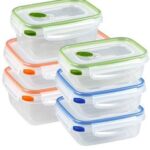Packaging for fresh produce serves several purposes, including protecting the items during transportation, maintaining their freshness, and providing information to consumers. Here are some common types of packaging used for fresh produce:
Plastic Bags: Clear or perforated plastic bags are commonly used for packaging items like leafy greens, vegetables, and fruits. These bags help keep the produce together and protect it from damage while allowing for airflow to prevent spoilage.
Clamshells: Clamshell containers are clear plastic containers with hinged lids that are commonly used for packaging berries, cherry tomatoes, and other small fruits or vegetables. They provide visibility of the produce while offering protection and easy handling.
Mesh Bags: Mesh bags made of plastic or nylon are often used for packaging items like onions, potatoes, and citrus fruits. These bags allow for airflow while providing some protection against bruising and damage.
Trays with Plastic Wrap: Some fresh produce, such as pre-cut fruits or vegetable trays, are packaged in plastic trays with a layer of plastic wrap to keep them fresh and hygienic. These trays are convenient for grab-and-go snacks and party platters.
Punnets: Punnets are small, shallow containers typically made of plastic or cardboard and are commonly used for packaging items like berries, cherry tomatoes, or grapes. They provide protection and visibility while allowing for easy stacking.
Boxes: Cardboard boxes are used for bulk packaging of produce items like apples, oranges, and potatoes. These boxes are sturdy and provide protection during transportation and handling.
Modified Atmosphere Packaging (MAP): MAP involves modifying the atmosphere inside the packaging to slow down the ripening process and extend the shelf life of fresh produce. This is often done by adjusting the levels of oxygen, carbon dioxide, and moisture inside the packaging.
Reusable Containers: Some retailers offer reusable containers or bags for customers to use when purchasing fresh produce as part of efforts to reduce single-use plastic waste.
Labeling and Branding: Packaging for fresh produce often includes labels with important information such as the product name, variety, origin, nutritional information, price, and barcodes for scanning at the checkout.
Sustainable Packaging: With increasing concerns about environmental sustainability, there is a growing trend towards using eco-friendly packaging materials such as compostable bags, recycled cardboard, or biodegradable plastics for fresh produce packaging.
Effective packaging for fresh produce not only protects the items but also enhances their presentation and ensures that they reach consumers in optimal condition. It plays a crucial role in preserving the quality and freshness of the produce while providing convenience and information to consumers.






